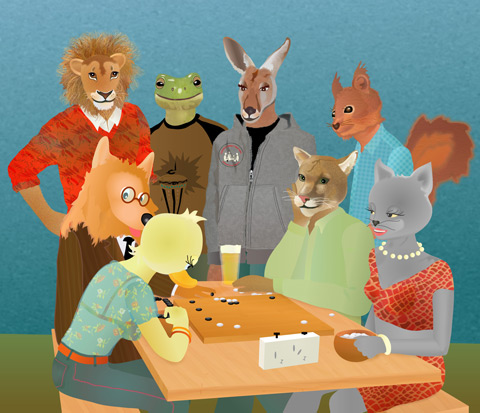Pair Go
Pair Go is a game format where a single game of go is played between teams of two players. The specific term "Pair Go" is usually used when referring to games where each team consists of one female and one male player. The more general form, where players can be of any gender, is usually referred to as Rengo. The rules are the same, however, so we will explain them here
The game format is sometimes generalized even further by allowing more than two players on each side.
In formal Pair Go, each player plays in turn without consultation. For informal pair go, anything the players agree on, including discussion before or after a move may occur.

| Table of contents |
Rules of Pair go
A summary of the ![[ext]](images/extlink.gif) Pair Go Association's rules:
Pair Go Association's rules:
- Two teams play, each a male/female pair.
- For handicap games, a team's grade is the mean of the individual players.
- Normal rotation is Black lady, White lady, Black man, White man, etc.
- In handicap games, the Black lady's first move is the placing of the handicap stones.
- During the game, no consultation except:
- Is it my turn?
- You played out of sequence.
- May I resign partner? (Yes, you may resign partner. / No, you may not.)
- If an out of sequence play is noticed before the next play and it was intentional, the game is forfeit by the player. If unintentional then a 3 prisoner penalty is handed over and normal rotation continues from the player under discussion. No moves are undone.
- A rotation error can only be claimed when the move just played was out of the rotation sequence. If the error was unintentional, the players are fined 3 points, if it was intentional they forfeit the game.
Pair Go has become an arena for tournaments, both local and international. See for example, World Pair Go Association and Japan Pair Go Association.
Playing strength
Rengo can be played with players of different strengths, the strength of the team is usually taken to be the average of the strength of the players. It is common to add the 'kyu values' (dans counting as negative), then divide by two.
Difference in strength between the teams can be compensated for by handicap as usual. As average strengths may include half ranks, this is sometimes compensated for additionally with komi.
Informal games
Rengos can be a good way for novice players, or weaker players to learn from stronger players. You may therefore find them being used as a vehicle for teaching, and a fair amount of discussion (kibbitz) going on during the game on what has been played.
Playing online
Several Go Servers support rengo matches.
- on OGS: check the "Rengo" box when creating a new game on the "play" page
- on IGS: type help team go
- on KGS: click New Game and choose Rengo as the game type
- DragonGoServer (turn-based server) supports Team-Go (since June 2012) with 3 up to 16 players set in 2 teams playing each other
- Arbitrary team-sizes are possible with N vs M players (e.g. 1:3, 2:2, 8:8, etc)
- Rengo is a special case of Team-Go with 2 vs 2 players
Pairings
The Japan Pair Go Association provides some rules on pair go, yet some topics seem to beg for more insight:
- assuming players are from the same group/club/family/etc (and there is no particular reason to form long-time teams), how should players with varying strenghts be paired, how should teams be set up?
- how are players seated; can seating make a difference?
- according to the page above, women are positioned first. courtesy rule? weak players first?
- how are komi and handicaps decided?
- according to the page, the handicap (for most cases) is derived from the rounded-up difference of the mean level between the two teams
- also, K6 for even games, -K6 (reverse komi) if difference is not fractional, else no komi
- as a side note, if free handicap placement is in use, it seems a natural and interesting process in pair go (both team members decide in turn where to put the next handicap stone)
- how is the clock managed?
- In real life, all 4 players will share one physical clock
- Online (an example is KGS), each player will have their time managed by the software.
Manners
The Japanese Pair Go Association recommends the following,
- Avoid unmannerly speech, conduct, attitudes, or dress.
- Avoid gestures or movements that can be construed as hints
- Refrain from trying to win on time when you have a lost game (no longer current)
- Gentlemen should wear coats and ties at official Pair Go tournaments
- At tournaments, do not smoke
- Partners should not leave the table together
See also
- Pair Go Strategy
- Pair Go Tournaments
- World Pair Go Association
- Ongoing Game
-
![[ext]](images/extlink.gif) EGC 2011 rules
EGC 2011 rules
- Sofia's mega rengo
![Sensei's Library [Welcome to Sensei's Library!]](images/stone-hello.png)
 Français
Français